Tom Dooley: The Kingston Trio
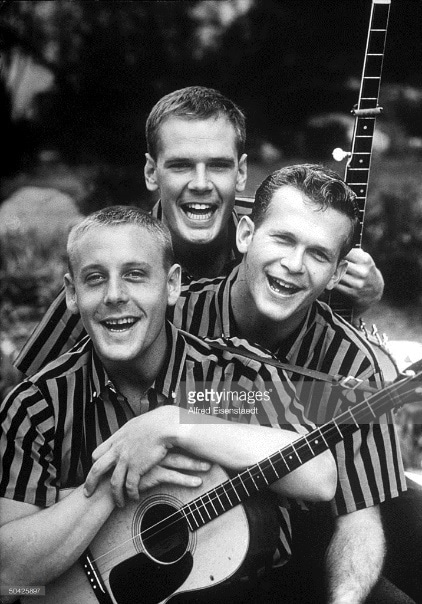 is a North Carolina folk song based on the 1866 murder of a woman named Laura Foster in Wilkes County, North Carolina, allegedly by Tom Dula.
is a North Carolina folk song based on the 1866 murder of a woman named Laura Foster in Wilkes County, North Carolina, allegedly by Tom Dula.
The song is best known today because of a hit version recorded in 1958 by The Kingston Trio. This version was a multi-format hit, which reached #1 in Billboard and the Billboard R&B listing, and appeared in the Cashbox Country Music Top 20.
It fits within the wider genre of Appalachian “sweetheart murder ballads”.
The song was selected as one of the American Songs of the Century by the Recording Industry Association of America (RIAA), the National Endowment for the Arts, and Scholastic Inc. Members of the Western Writers of America chose it as one of the Top 100 Western songs of all time.
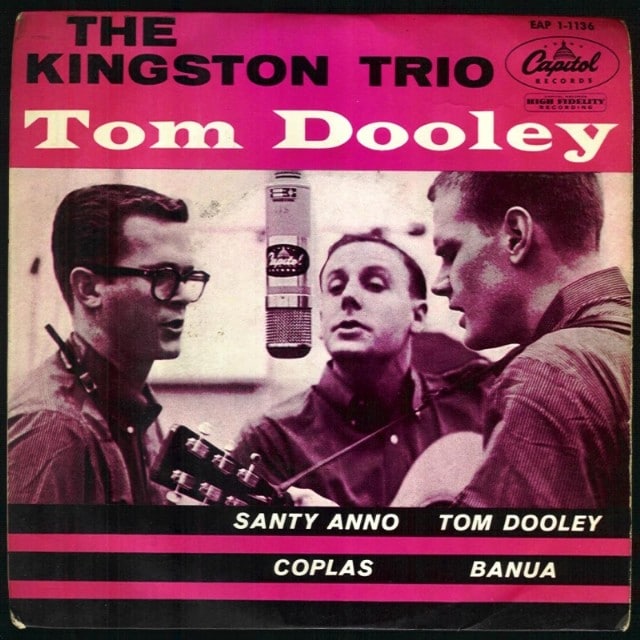
All I Have to Do Is Dream: The Everly Brothers
 is a popular song made famous by the Everly Brothers, written by Boudleaux Bryant of the husband and wife songwriting team Felice and Boudleaux Bryant, and published in 1958. By far the best-known version was recorded by The Everly Brothers and released as a single in April 1958. It had been recorded by The Everly Brothers live in just two takes on March 6, 1958, and features Chet Atkins on guitar. It was the only single ever to be at No. 1 on all of Billboard‘ singles charts simultaneously, on June 2, 1958.
is a popular song made famous by the Everly Brothers, written by Boudleaux Bryant of the husband and wife songwriting team Felice and Boudleaux Bryant, and published in 1958. By far the best-known version was recorded by The Everly Brothers and released as a single in April 1958. It had been recorded by The Everly Brothers live in just two takes on March 6, 1958, and features Chet Atkins on guitar. It was the only single ever to be at No. 1 on all of Billboard‘ singles charts simultaneously, on June 2, 1958.
It first reached No. 1 on the “Most played by Jockeys” and “Top 100” charts on May 19, 1958, and remained there for five and three weeks, respectively; with the August 1958 introduction of the Billboard Hot 100 chart, the song ended the year at No. 2. “All I Have to Do Is Dream” also hit No.1 on the R&B chart as well as becoming The Everly Brothers’ third chart topper on the country chart. The Everly Brothers briefly returned to the Hot 100 in 1961 with this song. It entered the U.K. Singles Chart on May 23, 1958, reaching the No. 1 position on July 4 and remaining there for seven weeks (including one week as a joint No. 1 with Vic Damone’s “On the Street Where You Live”), spending 21 weeks on the chart.
Little Star: The Elegants
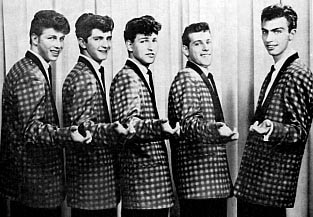 Littl4 is a song recorded by The Elegants. Members Vito Picone and Arthur Venosa co-wrote the lyrics.
Littl4 is a song recorded by The Elegants. Members Vito Picone and Arthur Venosa co-wrote the lyrics.
The music was adapted from “Twinkle Twinkle Little Star.” When released as a single in 1958, it topped both the R&B Best Sellers list and the Billboard Hot 100; however, it was the only song that ever charted for The Elegants.
Reportedly, the Elegants refused to pay payola to a prominent New York disc jockey, which inhibited air play of their follow up recordings.
Get A Job: The Silhouettes
is a song by the Silhouettes released in November 1957. It reached the number one spot on the Billboard pop and R&B singles charts in February 1958.
When I was in the service in the early 1950s and didn’t come home and go to work, my mother said ‘get a job’ and basically that’s where the song came from,” said tenor Richard Lewis, who wrote the lyrics. The four members of the group shared the credit, jointly creating the “sha na na” and “dip dip dip dip” hooks later imitated by other doo-wop groups.
The song was recorded at Robinson Recording Laboratories in Philadelphia in October 1957. Rollee McGill played the saxophone break, and the arranger was Howard Biggs. Intended as the B-side to “I Am Lonely”, “Get a Job” was initially released on Kae Williams’ Junior label; Williams, who was also a Philadelphia disc-jockey, was the Silhouettes’ manager. Doug Moody, an executive at Ember Records, acquired the rights to the song for that label where it was licensed for national distribution.
In early 1958, the Silhouettes performed “Get a Job” several times on American Bandstand and once on The Dick Clark Show, appearances that contributed to the song’s success by exposing it to a large audience. Ultimately the single sold more than a million copies
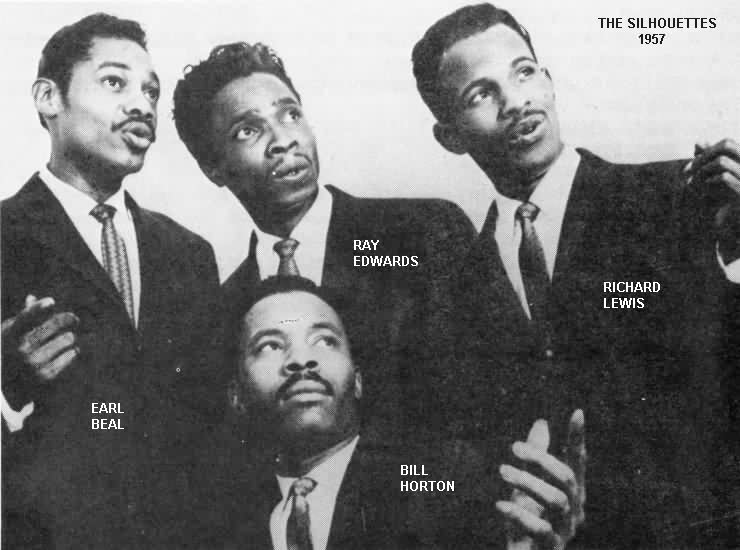
Maybe Baby: Buddy Holly and The Crickets
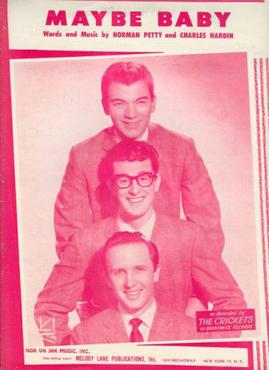 is a rock-and-roll song written by Buddy Holly and the producer Norman Petty and recorded by Holly and the Crickets in 1957. The single, credited to the Crickets, was a Top 40 hit in the U.S., the UK, and Canada. “Maybe Baby”, originally recorded by Holly and the Crickets in 1957, reached number 17 on the US charts and number 4 on the UK charts; Holly toured in the UK that year (see Buddy Holly discography). The single also reached number 8 on the Billboard R&B chart and number 9 on the Canadian charts. The rather simple lyrics are augmented by a twangy percussive accompaniment, characteristic of rockabilly, which is especially effective in the 8-bar instrumental introduction and the short conclusion.
is a rock-and-roll song written by Buddy Holly and the producer Norman Petty and recorded by Holly and the Crickets in 1957. The single, credited to the Crickets, was a Top 40 hit in the U.S., the UK, and Canada. “Maybe Baby”, originally recorded by Holly and the Crickets in 1957, reached number 17 on the US charts and number 4 on the UK charts; Holly toured in the UK that year (see Buddy Holly discography). The single also reached number 8 on the Billboard R&B chart and number 9 on the Canadian charts. The rather simple lyrics are augmented by a twangy percussive accompaniment, characteristic of rockabilly, which is especially effective in the 8-bar instrumental introduction and the short conclusion.
“Maybe Baby” was recorded at Tinker Air Force Base in Midwest City, Oklahoma in the wee hours of September 29, 1957, while Buddy Holly and The Crickets were on a tour (and played that same night, at Oklahoma City Municipal Auditorium with the Show Of Stars ’57. Jerry Allison from The Crickets personally remembers that the song, along with 3 others, was recorded there at Tinker Air Force Base. Graham Pugh, a Buddy Holly researcher from the Oklahoma City area, also has seen airplane tickets documenting the fact that Buddy Holly and The Crickets landed at Will Rogers World Airport in Oklahoma City on September 28, 1957.
Johnny B. Goode: Chuck Berry
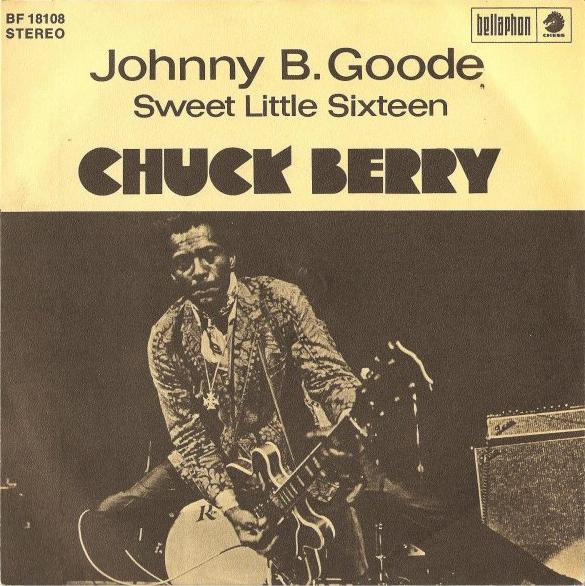
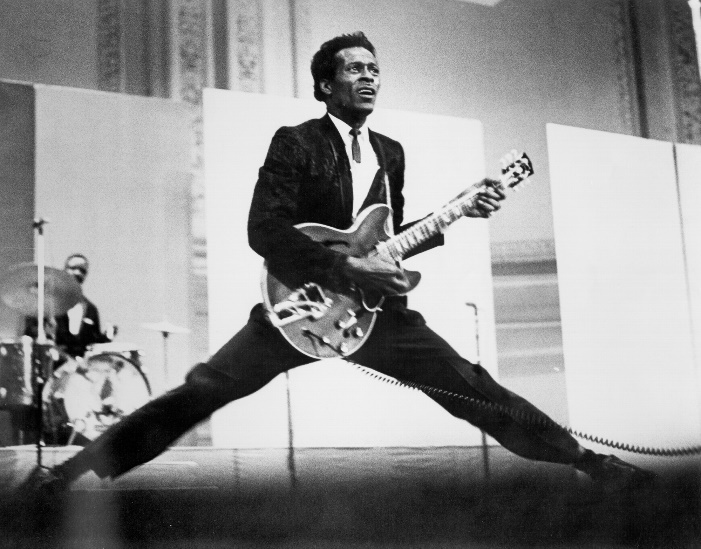
is a 1958 rock-and-roll song written and first recorded by Chuck Berry. The song was a major hit among both black and white audiences, peaking at number two on Billboard magazine’s Hot R&B Sides chart and number eight on its Hot 100 chart.
“Johnny B. Goode” is considered one of the most recognizable songs in the history of popular music. Credited as “the first rock & roll hit about rock & roll stardom”, it has been recorded by many other artists and has received several honors and accolades. The song is also ranked seventh on Rolling Stone‘s list of the “500 Greatest Songs of All Time”.
Written by Berry in 1955, the song is about an illiterate “country boy” from the New Orleans area, who plays a guitar “just like ringing a bell”, and who might one day have his “name in lights”. Berry acknowledged that the song is partly autobiographical and that the original lyrics referred to Johnny as a “colored boy”, but he changed it to “country boy” to ensure radio play. As well as suggesting that the guitar player is good, the title hints at autobiographic elements, because Berry was born at 2520 Goode Avenue, in St. Louis. The song was initially inspired by Johnnie Johnson, the regular piano player in Berry’s band, but developed into a song mainly about Berry himself. Johnson played on many other recordings by Berry, but Lafayette Leake played the piano on this song.
The opening guitar riff of “Johnny B. Goode” is essentially a note-for-note copy of the opening single-note solo on Louis Jordan’s “Ain’t That Just Like a Woman” (1946), played by guitarist Carl Hogan. Neither the guitar intro nor the solo are played at once. Berry played the introductory parts together with the rhythm guitar and later overdubbed the solo runs.
Berry wrote four more songs involving the character Johnny B. Goode, “Bye Bye Johnny”, “Go Go Go”, “Johnny B. Blues” and “Lady B. Goode”; and titled an album, and the nearly 19-minute instrumental title track from it, as “Concerto in B. Goode”.
Personnel
- Chuck Berry – vocals, guitars
- Lafayette Leake – piano
- Willie Dixon – double bass
- Fred Below – drums
At The Hop: Danny and The Juniors
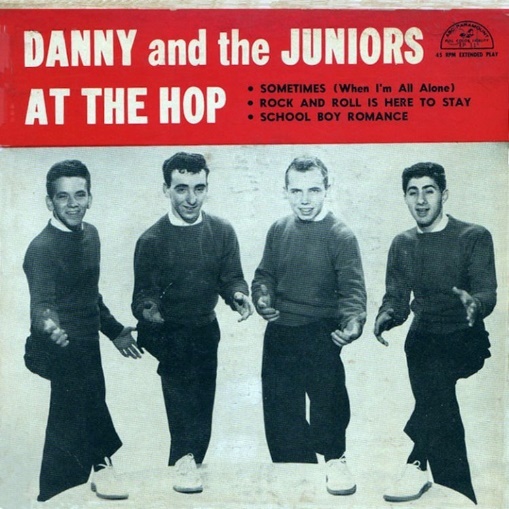
is a rock and roll/doo-wop song written by Artie Singer, John Medora, and David White and originally released by Danny & the Juniors. The song was released in the fall of 1957, and reached number one on the US charts on January 6, 1958, thus becoming one of the top-selling singles of 1958. “At the Hop” also hit number one on the R&B Best Sellers list. Somewhat more surprisingly, the record reached #3 on the Music Vendor country charts. It was also a big hit elsewhere, which included the group enjoying a number 3 placing with the song on the UK charts. The song was written by White, Medora, and Singer in 1957, when Danny & the Juniors were still called The Juvenairs. Initially called “Do the Bop”, the song was heard by Dick Clark, who suggested they change its name. After performing the song on Clark’s show American Bandstand, it gained popularity and went to the top of the US charts, remaining at number one for five weeks.
The song describes the scene at a record hop, particularly the dances being performed and the interaction with the disc jockey host.
Summertimes Blues: Eddie Cochran
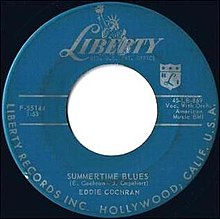 is a song co-written and recorded by American rockabilly artist Eddie Cochran. It was written by Cochran and his manager Jerry Capehart. Originally a single B-side, it was released in August 1958 and peaked at number 8 on the Billboard Hot 100 on September 29, 1958 and number 18 on the UK Singles Chart.
is a song co-written and recorded by American rockabilly artist Eddie Cochran. It was written by Cochran and his manager Jerry Capehart. Originally a single B-side, it was released in August 1958 and peaked at number 8 on the Billboard Hot 100 on September 29, 1958 and number 18 on the UK Singles Chart.
It has been covered by many artists, including being a number-one hit for country music artist Alan Jackson, and scoring notable hits in versions by The Who, Blue Cheer and Brian Setzer, the latter of whom recorded his version for the 1987 film La Bamba, where he portrayed Cochran.
Jimi Hendrix performed it in concert. “Summertime Blues” was recorded on March 28, 1958 at Gold Star Recording Studios in Hollywood, California. Eddie Cochran sang both the vocal and bass vocal (the “work-a-late” portions, Cochran’s tribute to the Kingfish character from the ‘’Amos and Andy’’ television series), played all the guitar parts, and added the hand clapping with possibly Sharon Sheeley. Connie ‘Guybo’ Smith played the electric bass and Earl Palmer drums.
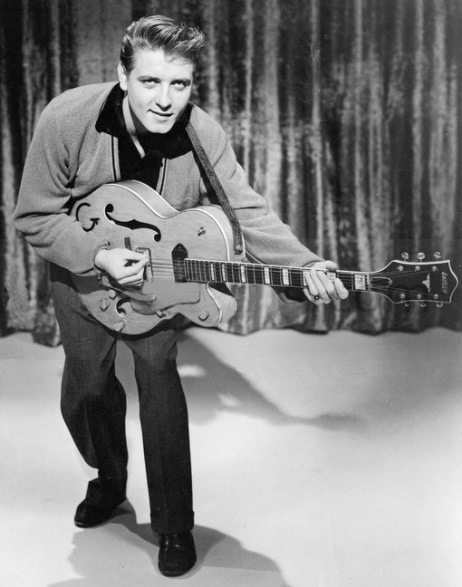
Smoke Gets In Your Eyes: The Platters
is a show tune written by American composer Jerome Kern and lyricist Otto Harbach for their 1933 musical Roberta. The song was sung in the original Broadway show by Tamara Drasin. Its first recorded performance was by Gertrude Niesen, who recorded the song with orchestral direction from Ray Sinatra, Frank Sinatra’s second cousin, on October 13, 1933. Niesen’s recording of the song was released by Victor, catalog# VE B 24454, with the B-side, “Jealousy”, featuring Isham Jones and his Orchestra.
Paul Whiteman had the first hit recording of the song on the record charts in 1934. The song was later reprised by Irene Dunne, who performed it in the original 1935 film adaptation of the musical, co-starring Fred Astaire, Ginger Rogers and Randolph Scott. The song was also included in the 1952 remake of Roberta, Lovely to Look At, in which it was performed by Kathryn Grayson, and was a chart hit in 1958 for The Platters.
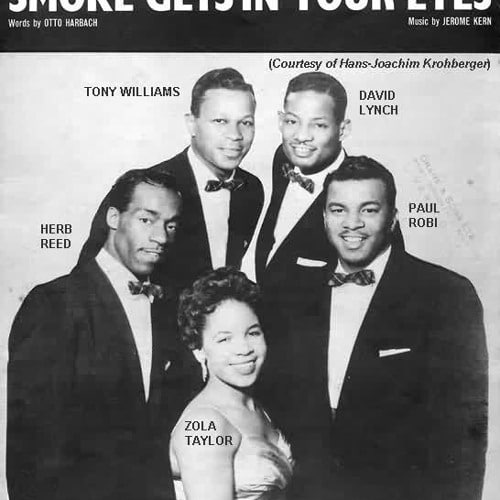
Possibly the most well-known version of “Smoke Gets in Your Eyes” was recorded in 1958 by The Platters, for their album Remember When?. The group’s cover became a number one hit in the U.S. on the Billboard Hot 100 music chart. In 1959 the version went on to peak at number three on the Rhythm and Blues chart. The song spent 20 weeks on the UK charts, peaking at Number 1 for one week on 20 March of that same year. The Platters’ producer, Buck Ram, reported that Harbach “congratulated Buck Ram and the Platters for reviving his song with taste.” Jerome Kern’s widow, on the other hand, disliked the recording so much she considered taking legal action to prevent its distribution.
Lipstick On Your Collar: Connie Francis
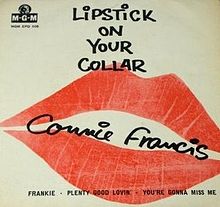 is a song written by Edna Lewis (lyrics) and George Goehring (music) which was a 1959 hit single for Connie Francis.
is a song written by Edna Lewis (lyrics) and George Goehring (music) which was a 1959 hit single for Connie Francis.
Francis recorded the song April 15 1959 in a session at Metropolitan Studio (NYC) produced and conducted by Ray Ellis. Veteran guitarist George Barnes contributed a solo to the track.
To provide a contrasting B-side for the upbeat track, a ballad from the same session: “Frankie”, was utilized. This Howard Greenfield/ Neil Sedaka composition was inspired by Frankie Avalon.
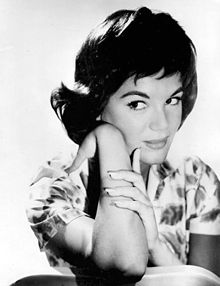 “Lipstick on Your Collar” became the first uptempo Connie Francis single to reach the US Top Ten, peaking at No. 5 on the Billboard Hot 100 in July 1959. That summer the track also reached No. 3 in the UK Singles Chart, and became Francis’ first Top Ten hit in Australia at No. 4. It sold over one million copies in the US alone.
“Lipstick on Your Collar” became the first uptempo Connie Francis single to reach the US Top Ten, peaking at No. 5 on the Billboard Hot 100 in July 1959. That summer the track also reached No. 3 in the UK Singles Chart, and became Francis’ first Top Ten hit in Australia at No. 4. It sold over one million copies in the US alone.
“Frankie” also became a Top Ten hit in the US with a #9 peak making the “Lipstick on Your Collar”/ “Frankie” single the most successful double-sided hit of Francis’ career.
In a 1959 interview, Francis attributed her being the sole songstress then scoring rock and roll hits by saying: “Rock ‘n’ roll is a masculine kind of music” with its mindset of “‘Come on out baby we’re going to rock’..[best] suited for a man to sing…The mistake that many girl singers have made is trying to compete with the men [whereas] I’ve tried for the cute angle in lyrics, things like ‘Lipstick on Your Collar’ and ‘Stupid Cupid’.
A Teenager in Love: Dion and The Belmonts
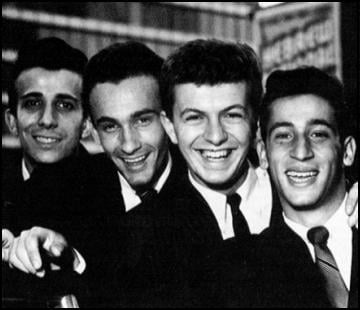 is a song written by Doc Pomus and partner Mort Shuman and was originally sung and released by Dion and the Belmonts in March 1959.
is a song written by Doc Pomus and partner Mort Shuman and was originally sung and released by Dion and the Belmonts in March 1959.
It reached #5 on the Billboard pop charts.
In May 1959, the song held three positions in the British Top 20, the other two versions being by Marty Wilde and Craig Douglas.
The song is considered one of the greatest songs in rock and roll history.
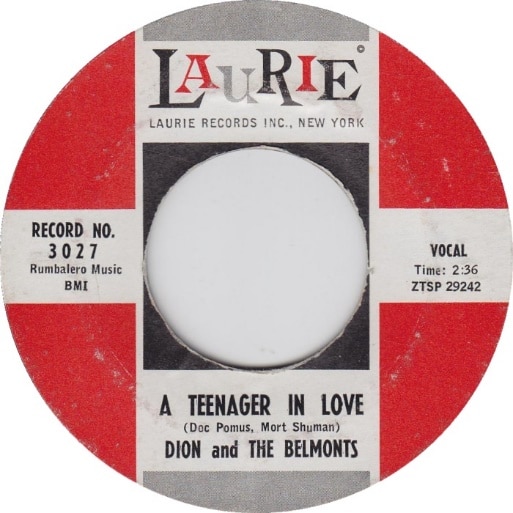
La Bamba: Ritchie Valens
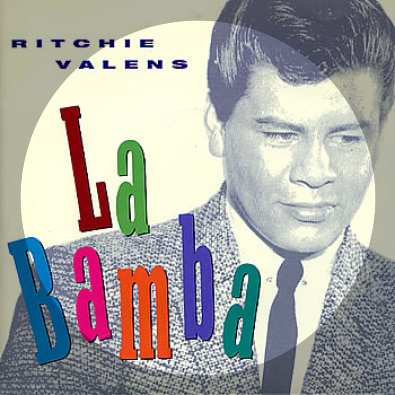 The traditional song inspired Ritchie Valens’ rock and roll version “La Bamba” in 1958. Valens’ “La Bamba” infused the traditional tune with a rock drive, in part provided by session musicians Earl Palmer and Carol Kaye, making the song popular with a much wider record audience and earning it (and Valens) a place in rock history (he was inducted posthumously into the Rock & Roll Hall of Fame in 2001).
The traditional song inspired Ritchie Valens’ rock and roll version “La Bamba” in 1958. Valens’ “La Bamba” infused the traditional tune with a rock drive, in part provided by session musicians Earl Palmer and Carol Kaye, making the song popular with a much wider record audience and earning it (and Valens) a place in rock history (he was inducted posthumously into the Rock & Roll Hall of Fame in 2001).
The musicians on that session were Buddy Clark: string bass, Ernie Freeman: piano, Carol Kaye: acoustic rhythm guitar, Rene Hall: Danelectro guitar (six-string baritone guitar), Earl Palmer: drums and claves, Ritchie Valens: vocals, lead guitar.
The song features a simple verse-chorus form. Valens, who was proud of his Mexican heritage, was hesitant at first to merge “La Bamba” with rock and roll but then agreed. The song ranked No. 98 in VH1’s 100 Greatest Songs of Rock and Roll in 1999, and No. 59 in VH1’s 100 Greatest Dance Songs in 2000. Furthermore, Valens’ recording of the song was inducted into the Latin Grammy Hall of Fame.
When the Los Lobos cover of Valens’ version peaked at No. 1 on the Billboard Hot 100 chart in 1987, Valens was retroactively credited with writing a No. 1 single.
Yakety Yak: The Coasters
is a song written, produced, and arranged by Jerry Leiber and Mike Stoller for The Coasters and released on Atlantic Records in 1958, spending seven weeks as #1 on the R&B charts and a week as number one on the Top 100 pop list. This song was one of a string of singles released by The Coasters between 1957 and 1959 that dominated the charts, one of the biggest performing acts of the rock and roll era.
The song is a “playlet,” a word Stoller used for the glimpses into teenage life that characterized the songs Leiber and Stoller wrote and produced. The lyrics describe the listing of household chores to a kid, presumably a teenager, the teenager’s response (“yakety yak”) and the parents’ retort (“don’t talk back”) — an experience very familiar to a middle-class teenager of the day. Leiber has said the Coasters portrayed “a white kid’s view of a black person’s conception of white society.” The serio-comic street-smart “playlets” etched out by the songwriters were sung by the Coasters with a sly clowning humor, while the saxophone of King Curtis filled in, in the up-tempo doo-wop style. The group was openly “theatrical” in style—they were not pretending to be expressing their own experience.
The threatened punishment for not taking out the garbage and sweeping the floor is, in the song’s humorous lyrics:
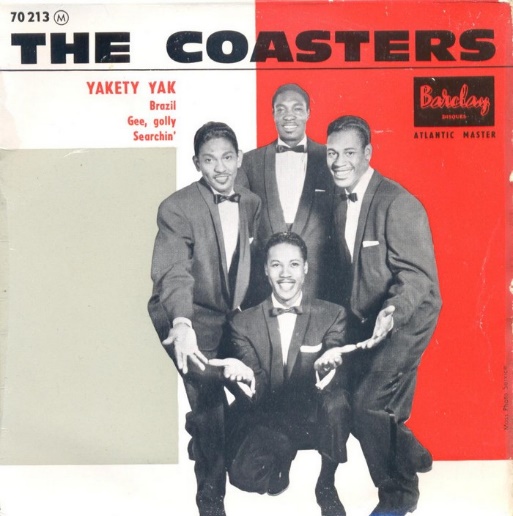
Sweet Little Sixteen: Chuck Berry
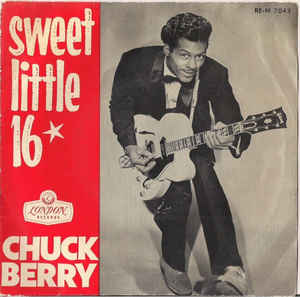 is a rock and roll song written and first recorded by Chuck Berry, who released it as a single in January 1958. His performance of it at that year’s Newport Jazz Festival was included in the documentary film Jazz on a Summer’s Day. It reached number two on the Billboard Hot 100, Berry’s second-highest position ever on that chart (surpassed only by his suggestive hit “My Ding-A-Ling”, which reached number one in 1972).
is a rock and roll song written and first recorded by Chuck Berry, who released it as a single in January 1958. His performance of it at that year’s Newport Jazz Festival was included in the documentary film Jazz on a Summer’s Day. It reached number two on the Billboard Hot 100, Berry’s second-highest position ever on that chart (surpassed only by his suggestive hit “My Ding-A-Ling”, which reached number one in 1972).
“Sweet Little Sixteen” also reached number one on the R&B Best Sellers chart. In the UK, it reached number 16 on the UK Official Charts. Rolling Stone magazine ranked the song number 272 on its list of the “500 Greatest Songs of All Time” in 2004.
Tequila: The Champs
is a 1958 Latin-flavored rock and roll instrumental recorded by the Champs. It is based on a Cuban mambo beat. The word “Tequila” is spoken three times throughout the tune. “Tequila” became a #1 hit on both the pop and R&B charts at the time of its release and continues to be strongly referenced in pop culture to this day.
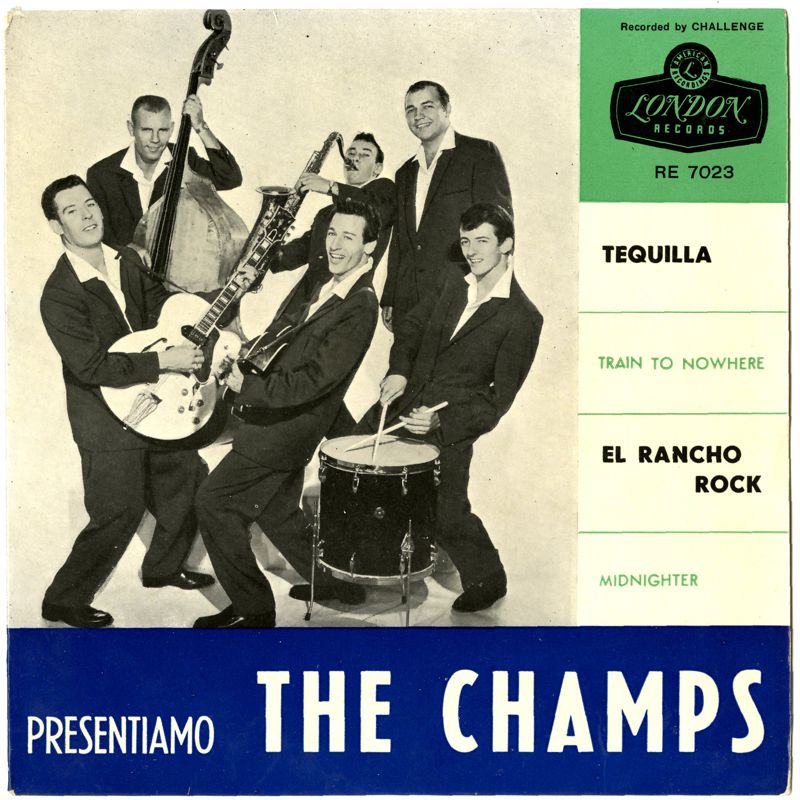
n 1957, Gene Autry’s record label, Challenge Records, signed Dave Burgess (born 1934), a rockabilly singer-songwriter from California who often recorded under the name “Dave Dupree”. At the end of 1957, having produced no hits, Challenge Records looked to Burgess, who organized a recording session on December 23 in Hollywood. In the studio that day were Burgess on rhythm guitar, Cliff Hills on bass guitar, the Flores Trio (Danny Flores on saxophone and keyboards, Gene Alden on drums, and lead guitarist Buddy Bruce), and Huelyn Duvall contributing backing vocals. They gathered primarily to record “Train to Nowhere”, a song by Burgess, as well as “Night Beat” and “All Night Rock”.
The last tune recorded was “Tequila”, essentially just a jam by the Flores Trio. There were three takes, and Danny Flores, who wrote the song, was also the man who actually spoke the word “Tequila!”. Flores also played the trademark “dirty sax” solo. The song served as the B-side for “Train to Nowhere”, which was released by Challenge Records on January 15, 1958. Duvall recalls that the record initially found little success, but, after a DJ in Cleveland played the B-side, “Tequila” skyrocketed up the charts, reaching #1 on the Billboard chart on March 28, 1958.
Daniel Flores had written “Tequila”, but, because he was signed to another label, the tune was credited to “Chuck Rio”, a name he adopted for the stage. Those present for the December 23 session began recording together again on January 20, 1958, under the name the Champs; the group technically formed after recording “Tequila”. The tune has been noted to have a similar rhythm structure to Bo Diddley’s 1958 release “Dearest Darling”.
Challenge Records was founded in Los Angeles in 1957 by cowboy singer Gene Autry and former Columbia Records A&R representative Joe Johnson. Autry’s involvement with the label was short lived as he sold his interest to the remaining partners in October 1958. The label’s first success came with instrumental group the Champs, who had their biggest hit in 1958 with “Tequila”. They also had a series of hits with pop singer Jerry Wallace (“Primrose Lane”) and country singer Wynn Stewart (“Wishful Thinking”). Other recording artists with the label included Jan and Dean, Gary Usher, the Knickerbockers, and singer-songwriter Jerry Fuller. The first Challenge label was blue with silver print, followed after the first half dozen releases by a short-lived light-blue label with red print, then a maroon-colored label with silver print. Finally, around late 1959, the company issued their singles on a green label with silver print.
The Champs recorded a sequel to “Tequila” entitled “Too Much Tequila”. Released as a maroon-label Challenge single, it reached #30 on the Billboard Hot 100.
Mack The Knife: Bobby Darin
a song composed by Kurt Weill with lyrics by Bertolt Brecht for their music drama Die Dreigroschenoper, or, as it is known in English, The Threepenny Opera. It premiered in Berlin in 1928 at the Theater am Schiffbauerdamm. The song has become a popular standard recorded by many artists, including a US and UK number one hit for Bobby Darin in 1959.
Mack the Knife” was introduced to the United States hit parade by Louis Armstrong in 1956, but the song is most closely associated with Bobby Darin, who recorded his version at Fulton Studios on West 40th Street, New York City, on December 19, 1958 (with Tom Dowd engineering the recording). Even though Darin was reluctant to release the song as a single, in 1959 it reached number one on the Billboard Hot 100 and number six on the Black Singles chart, and earned him a Grammy Award for Record of the Year. Dick Clark had advised Darin not to record the song because of the perception that, having come from an opera, it would not appeal to the rock and roll audience.
Battle of New Orleans: Johnny Horton
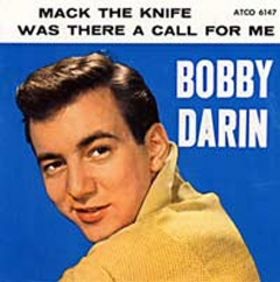 is a song written by Jimmy Driftwood. The song describes the War of 1812 Battle of New Orleans from the perspective of an American soldier; the song tells the tale of the battle with a light tone and provides a rather comical version of what actually happened at the battle.
is a song written by Jimmy Driftwood. The song describes the War of 1812 Battle of New Orleans from the perspective of an American soldier; the song tells the tale of the battle with a light tone and provides a rather comical version of what actually happened at the battle.
It has been recorded by many artists, but the singer most often associated with this song is Johnny Horton.
His version scored number 1 on the Billboard Hot 100 in 1959 (see 1959 in music).
Billboard ranked it as the No. 1 song for 1959, it was very popular with teenagers in the late 50’s/early 60’s in an era mostly dominated by rock and roll music.
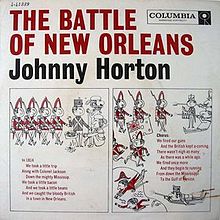 In Billboard magazine’s rankings of the top songs in the first 50 years of the Billboard Hot 100 chart, “The Battle of New Orleans” was ranked as the 28th song overall and the number-one country music song to appear on the chart.
In Billboard magazine’s rankings of the top songs in the first 50 years of the Billboard Hot 100 chart, “The Battle of New Orleans” was ranked as the 28th song overall and the number-one country music song to appear on the chart.
Members of the Western Writers of America chose it as one of the Top 100 Western songs of all time
.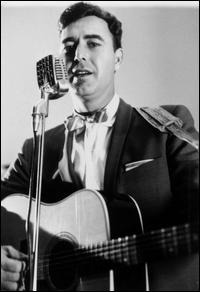
Poor Little Fool: Ricky Nelson
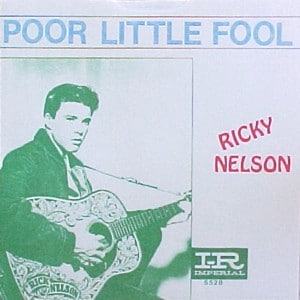 is a rock and roll song written by Sharon Sheeley and first recorded by Ricky Nelson in 1958.
is a rock and roll song written by Sharon Sheeley and first recorded by Ricky Nelson in 1958.
Sheeley wrote the song when she was fifteen years old. She had met Elvis Presley, and he encouraged her to write. It was based on her disappointment following a short-lived relationship with a member of a popular singing duo. Sheeley sought Ricky Nelson to record the tune. She drove to his house, and claimed her car had broken down. He came to her aid, and she sprang the song on him. Her version was at a much faster tempo than his recording.
The song was recorded by Ricky Nelson on April 17, 1958, and released on Imperial Records through its catalog number: 5528. It was the first number-one song on Billboard magazine’s then-new Hot 100 chart, replacing the magazine’s Jockeys and Top 100 charts. It spent two weeks at the number-one spot. It also reached the top ten on the Billboard Country and Rhythm and Blues charts. Following its success, Sheeley worked with Eddie Cochran.
“Poor Little Fool” became a radio hit when it was released as part of a four-song Extended Play 45 rpm disc which was excerpted from the artist’s second LP, Ricky Nelson. Responding to the buzz, Lew Chudd, the founder and head of Imperial Records, rushed out a single version (on both 45 and 78 rpm). Nelson objected, however, believing that the move would hurt sales of the EP. Under his contract with Imperial, the singer had approval rights for all picture-sleeve art and to express his displeasure with Chudd’s decision, he chose not to select a photograph for the “Poor Little Fool” single. As a result, “Poor Little Fool” was the only Ricky Nelson single released by Imperial to be issued in the United States without a photo in a plain label-cut-out sleeve
A Big Hunk o’ Love: Elvis Presley
is a song written by Aaron Schroeder and Sid Wyche, a.k.a. Sid Jaxon. The former is best known for writing the jazz standard “Alright, Okay, You Win”, whereas Aaron Schroeder co-wrote a whole bunch of hits from the rock`n`roll area, from “Fools Hall of Fame” (Pat Boone) to “Because They’re Young” (Duane Eddy). In an interview conducted by Jan-Erik Kjeseth, he also revealed that in fact he worked with his partner Wally Gold in order to improve a song submitted by another writer, and the end result was “It’s My Party”, a big hit for Lesley Gore. Schroeder and Gold tossed a coin as to whose name should go on the record, and Gold “won”. Other titles written by the duo include “It’s Now or Never” and “Good Luck Charm”; both of which – like “A Big Hunk o’ Love” – were originally recorded by American rock and roll icon Elvis Presley. “A Big Hunk o’ Love” was released as a single on June 23, 1959 by RCA Victor and later topped the Billboard Hot 100 for two weeks
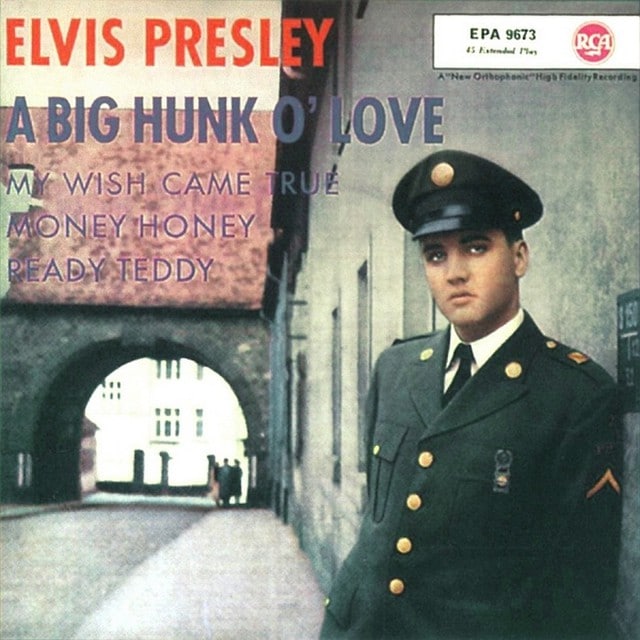
What I’d Say: Ray Charles
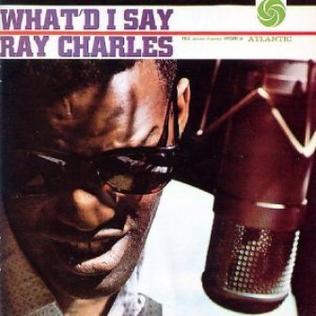 is an American rhythm and blues song by Ray Charles, released in 1959. As a single divided into two parts, it was one of the first soul songs.
is an American rhythm and blues song by Ray Charles, released in 1959. As a single divided into two parts, it was one of the first soul songs.
The composition was improvised one evening late in 1958 when Charles, his orchestra, and backup singers had played their entire set list at a show and still had time left; the response from many audiences was so enthusiastic that Charles announced to his producer that he was going to record it.
After his run of R&B hits, this song finally broke Charles into mainstream pop music and itself sparked a new subgenre of R&B titled soul, finally putting together all the elements that Charles had been creating since he recorded “I Got a Woman” in 1954. The gospel and rhumba influences combined with the sexual innuendo in the song made it not only widely popular but very controversial to both white and black audiences. It earned Ray Charles his first gold record and has been one of the most influential songs in R&B and rock and roll history. For the rest of his career, Charles closed every concert with the song. It was added to the National Recording Registry in 2002 and ranked at number 10 in Rolling Stone‘s “The 500 Greatest Songs of All Time”.
Ray Charles was 28 years old in 1958, with ten years of experience recording primarily rhythm and blues music for the Downbeat and Swingtime record labels, in a style similar to that of Nat King Cole and Charles Brown. Charles signed with Atlantic Records in 1954 where producers Ahmet Ertegun and Jerry Wexler encouraged him to broaden his repertoire. Wexler would later remember that Atlantic Records’ success came not from the artists’ experience, but the enthusiasm for the music: “We didn’t know shit about making records, but we were having fun”. Ertegun and Wexler found that a hands-off approach was the best way of encouraging Charles. Wexler later said, “I realized the best thing I could do with Ray was leave him alone
A Lover’s Question
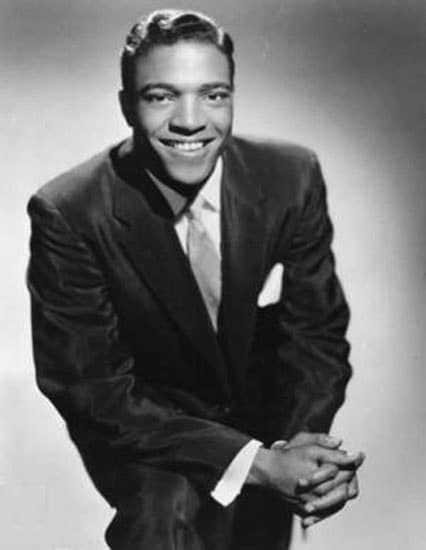 is a 1958 Pop, R&B hit for Clyde McPhatter. The single was written by Brook Benton and Jimmy T. Williams and was Clyde McPhatter’s most successful Pop and R&B release.
is a 1958 Pop, R&B hit for Clyde McPhatter. The single was written by Brook Benton and Jimmy T. Williams and was Clyde McPhatter’s most successful Pop and R&B release.
The bass singer is Noah Hopkins. “A Lover’s Question” made it to #6 on the Billboard Hot 100 and was #1 for one week on the R&B chart. Country singer Del Reeves took the song to #14 on the Hot Country Singles chart in 1970.
The best-known version of the song is in mono. However, a stereo version was released on the LP Atlantic History of Rhythm & Blues, Vol. 4, along with several other rare stereo versions of late 1950s Atlantic hits.
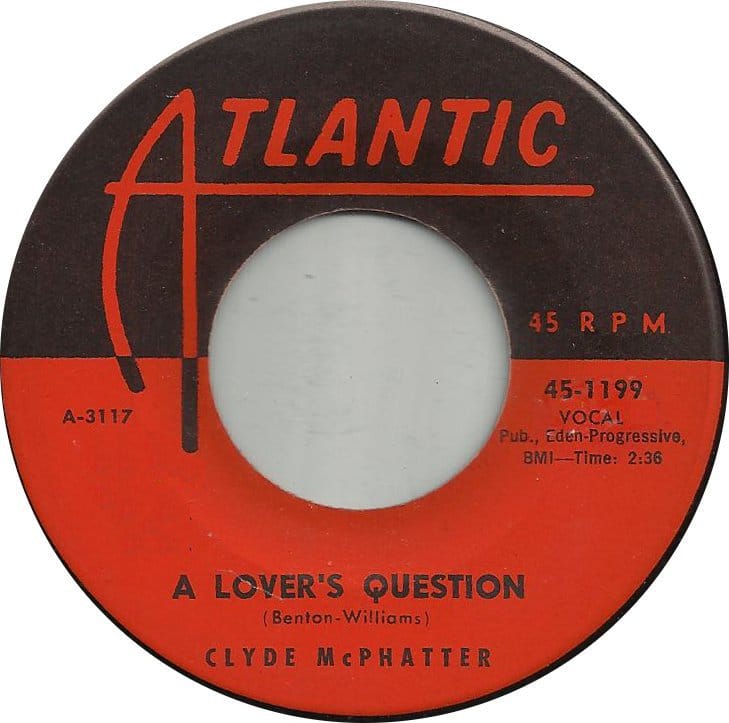
I Only Have Eyes For You: The Flamingos
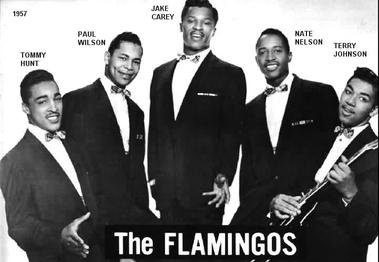 is a romantic love song by composer Harry Warren and lyricist Al Dubin, written for the film Dames (1934) where it was introduced by Dick Powell and Ruby Keeler.
is a romantic love song by composer Harry Warren and lyricist Al Dubin, written for the film Dames (1934) where it was introduced by Dick Powell and Ruby Keeler.
The song is a jazz standard, and has been covered by numerous musicians. Successful recordings of the song have been made by Ben Selvin (in 1934), The Flamingos (in 1959), The Lettermen (in 1966) and Art Garfunkel (in 1975), among others.
This song was included on The Flamingos’ debut album Flamingo Serenade. The version by the Flamingos features a prominent reverb effect, creating a dreamy ambience. This version peaked at number 11 on the US Billboard Hot 100 chart and #3 on the Billboard Hot R&B/Hip-Hop Songs chart. It ranked as the 73rd biggest hit of 1959 by Billboard. Rolling Stone magazine ranked the Flamingos’ version #157 on their list of the 500 Greatest Songs of All Time.
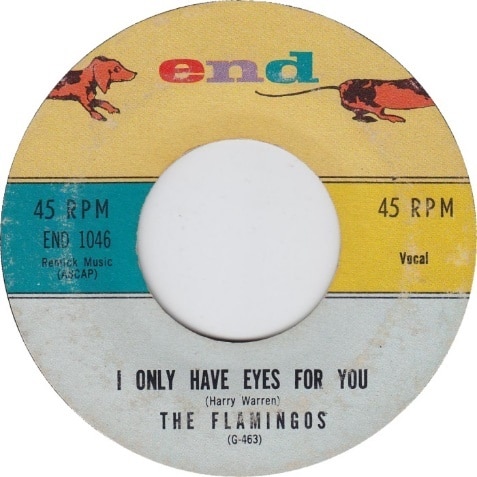
Venus: Frankie Avalon
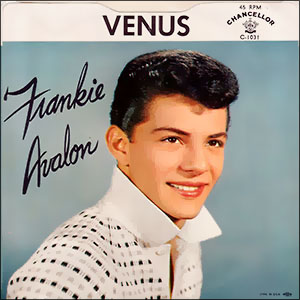 is a song written by Ed Marshall and Peter DeAngelis. The most successful and best-known recording of the track was done by Frankie Avalon and released in 1959 (see 1959 in music).
is a song written by Ed Marshall and Peter DeAngelis. The most successful and best-known recording of the track was done by Frankie Avalon and released in 1959 (see 1959 in music).
Venus became Avalon’s first number-one hit on the Billboard Hot 100 chart, where it spent five weeks atop the survey.
The song also reached number ten on the R&B chart. The song’s lyrics detail a man’s plea to Venus, the Roman goddess of love and beauty, to send him a girl to love and one who will love him as well. Billboard ranked it as the No. 4 song for 1959.
Sleep Walk: Santo and Johnny
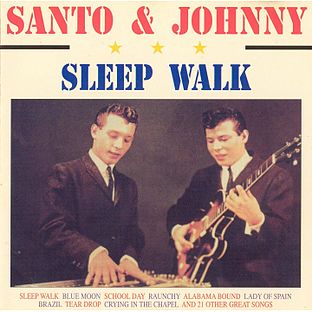 is an instrumental song written, recorded, and released in 1959 by brothers Santo & Johnny Farina, with their uncle Mike Dee playing the drums. Prominently featuring steel guitar, the song was recorded at Trinity Music in Manhattan, New York City.
is an instrumental song written, recorded, and released in 1959 by brothers Santo & Johnny Farina, with their uncle Mike Dee playing the drums. Prominently featuring steel guitar, the song was recorded at Trinity Music in Manhattan, New York City.
“Sleep Walk” entered Billboard‘s Top 40 on August 17, 1959. It rose to the number 1 position for the last two weeks in September and remained in the Top 40 until November 9.
“Sleep Walk” also reached number 4 on the R&B chart. It was the last instrumental to hit number one in the 1950s and earned Santo & Johnny a gold record. In the UK it peaked at number 22 on the charts.
16 Candles: The Crests
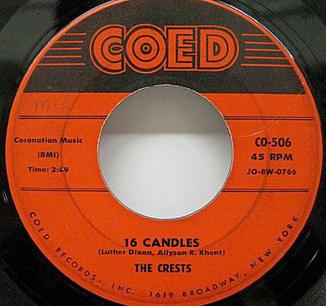 is a 1958 song performed by The Crests and written by Luther Dixon and Allyson R. Khent.
is a 1958 song performed by The Crests and written by Luther Dixon and Allyson R. Khent.
The song peaked at number two on the Billboard Hot 100 charts and number four on the R&B charts in 1959
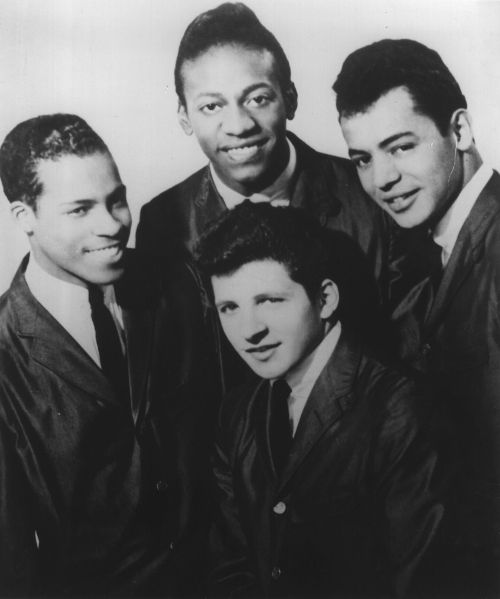
Kansa City: Wilbert Harrison
Is a rhythm and blues song written by Jerry Leiber and Mike Stoller in 1952. First recorded by Little Willie Littlefield the same year, the song later became a #1 hit when it was recorded by Wilbert Harrison in 1959. “Kansas City” became one of Leiber and Stoller’s “most recorded tunes, with more than three hundred versions,” with several appearing in the R&B and pop record charts.
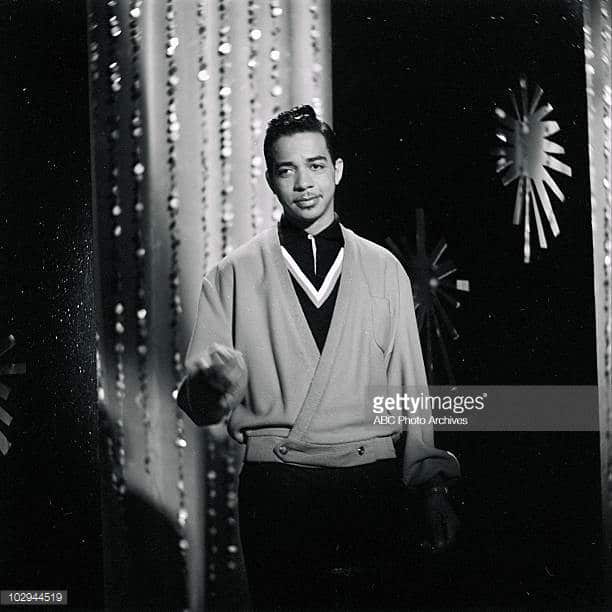 In 1959, after several years of performing Littlefield’s “K. C. Loving”, Wilbert Harrison decided to record the song. In March 1959, just when the version of Little Richard was released on album, Harrison, with a trio including guitarist Wild Jimmy Spruill, recorded it in a New York studio for producer Bobby Robinson of Fury Records. “Kansas City” was released on a single by Fury, catalog number 1023, later that year.
In 1959, after several years of performing Littlefield’s “K. C. Loving”, Wilbert Harrison decided to record the song. In March 1959, just when the version of Little Richard was released on album, Harrison, with a trio including guitarist Wild Jimmy Spruill, recorded it in a New York studio for producer Bobby Robinson of Fury Records. “Kansas City” was released on a single by Fury, catalog number 1023, later that year.
Although the song’s arrangement varied little from Littlefield’s, it “struck such a solid shuffle groove that it was unforgettable”, with inspired rhythm and solo guitar work by Spruill. Harrison’s song was issued with Leiber and Stoller’s original name, “Kansas City”, but changed the refrain to “They got some crazy little women there, and I’m gonna get me one” and dropped one twelve-bar section.

Shortly after the song’s release, several other versions appeared. Billboard magazine’s pop song pick of the week for March 30, 1959 listed five different releases of “Kansas City”: Harrison’s and versions by Hank Ballard and The Midnighters (King 5195), Rocky Olson (Chess 1723), Rockin’ Ronald & the Rebels (End 1043), and a reissue by Littlefield (Federal 12351). A week later, the magazine announced the single release of a version by Little Richard. Although Ballard’s and Richard’s versions both appeared in the lower reaches of the Billboard charts, Harrison’s was a runaway hit, reaching number one in both the R&B and pop charts, where it remained for seven weeks, and became one of the top selling records of 1959. It was also the final No. 1 single in the US to be released on a 78 record.
Lonely Teardrops: Jackie Wilson
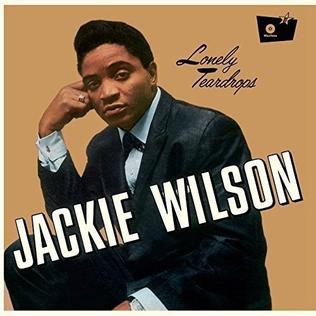 is a song recorded and released as a single in 1958 by R&B, Soul, and Rock n Roll singer Jackie Wilson on the Brunswick label. It is a 1999 Grammy Hall of Fame Inductee. The song became an across-the-board national Top 10 Pop smash (# 7),a # 1 hit on the R&B charts, and is ranked #315 on Rolling Stone magazine’s list of The 500 Greatest Songs of All Time. It is ranked as the 57th biggest U.S. hit of 1959. “Lonely Teardrops” is also listed on the Rock and Roll Hall of Fame’s list of “The 500 Songs that Shaped Rock and Roll”. ritten by Berry Gordy Jr., Gwendolyn Gordy (Berry’s sister) and Roquel “Billy” Davis, going under the pseudonym Tyran Carlo, the single, alongside Wilson’s debuting five consecutive singles between 1957–58, turned Wilson into an R&B superstar and influenced the later careers of Davis, who joined the staff of Chess Records while Gordy used the money from the song’s success to form Motown Records within a year. The song raced up to number one on the Billboard R&B chart and became Wilson’s first top ten hit on the Billboard Hot 100, eventually peaking at number seven. It was originally intended by Gordy to be recorded as a ballad. After recording it, Wilson and Brunswick executives felt the song lacked something. It was then given to veteran Decca Records arranger Dick Jacobs who re-arranged it into the smash hit it became. The hit’s success helped land Wilson on American Bandstand and The Ed Sullivan Show performing to receptive audiences on the respective shows, as well as other shows such as Shindig and Hullabaloo.
is a song recorded and released as a single in 1958 by R&B, Soul, and Rock n Roll singer Jackie Wilson on the Brunswick label. It is a 1999 Grammy Hall of Fame Inductee. The song became an across-the-board national Top 10 Pop smash (# 7),a # 1 hit on the R&B charts, and is ranked #315 on Rolling Stone magazine’s list of The 500 Greatest Songs of All Time. It is ranked as the 57th biggest U.S. hit of 1959. “Lonely Teardrops” is also listed on the Rock and Roll Hall of Fame’s list of “The 500 Songs that Shaped Rock and Roll”. ritten by Berry Gordy Jr., Gwendolyn Gordy (Berry’s sister) and Roquel “Billy” Davis, going under the pseudonym Tyran Carlo, the single, alongside Wilson’s debuting five consecutive singles between 1957–58, turned Wilson into an R&B superstar and influenced the later careers of Davis, who joined the staff of Chess Records while Gordy used the money from the song’s success to form Motown Records within a year. The song raced up to number one on the Billboard R&B chart and became Wilson’s first top ten hit on the Billboard Hot 100, eventually peaking at number seven. It was originally intended by Gordy to be recorded as a ballad. After recording it, Wilson and Brunswick executives felt the song lacked something. It was then given to veteran Decca Records arranger Dick Jacobs who re-arranged it into the smash hit it became. The hit’s success helped land Wilson on American Bandstand and The Ed Sullivan Show performing to receptive audiences on the respective shows, as well as other shows such as Shindig and Hullabaloo.
This was the last song Jackie Wilson performed before his coma and later death, when he collapsed on-stage singing it while appearing as one of the feature acts in Dick Clark’s Good Ol’ Rock and Roll Revue in 1975.
